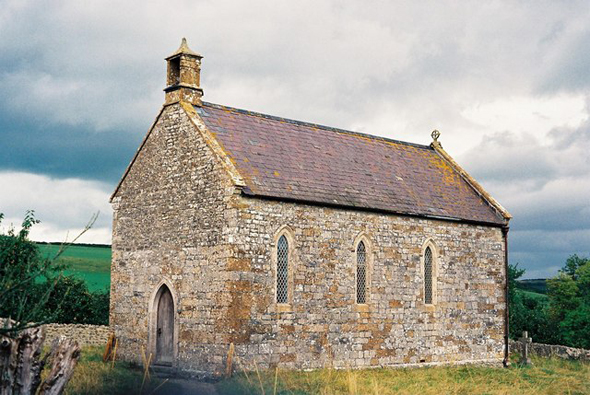
Toller Fratrum. The parish church dedicated to St. Basil. Photo by Chris Downer http://www.geograph.org.uk/profile/14700
Helping you discover your Dorset Ancestors
During the 11th century the Knights Hospitallers, the brethren of St. John of Jerusalem, came to the area below Beaminster Heights and Toller Down and settled in what became known as Toller Fratrum. Toller is a reference to the Hundred of Tollerford and Fratrum is Latin for Brothers. Here the knights set up home and built their storehouses.
The church we see here today is from the 19th century but inside there are two ancient relics. In the wall and dating from the 12th century is a fragment of a relief illustrating Mary Magdalene wiping Christ’s feet with her hair and the tub-shaped font strangely decorated with archaic figures including a two headed monster that may be of Saxon date. The church is of a simple single cell design comprising a nave, chancel and small bell-turret.
It is one of only three churches in England dedicated to St. Basil the Great, an honour more usually bestowed on churches in the east. St. Basil ruled over fifty bishoprics in the fourth century. Over looking the river Hooke, a tributary of the river Frome, the church is set a little aside from the manor house, farm buildings and workers cottages that make up this hamlet, the smallest of the three Tollers; the others being Toller Porcorum or Great Toller and Toller Whelme.
The Manor House, built on the site of the original Knight’s home and nowadays known as Little Toller Farm, and the thatched outbuilding were erected in 1540 by John Samway of Winterbourne Martin, who purchased the estate in 1540. The west of the house was added later. There is a chimney breast near the centre with two tall twisted stacks and a gable finial carved as a monkey with a mirror.
On John Samway’s death in 1586 the manor passed to Robert Samway, who left it to Bernard Samway when he died in 1620. Through marriage Toller Fratrum became the property of Francis Fulford of Devon and remained in this family for over a century. The Tudor work including several Tudor windows must be credited to John Samway but it was the Royalist Sir Thomas Fulford who was responsible for adding the west part of the building.
The Fulford family were also joined in marriage with the Sydenham’s who, in the middle of the 16th century, moved into the Manor of neighbouring Wynford Eagle, coming originally from Somerset. The marriage of Thomas Sydenham to Elizabeth Fulford is recorded at Wynford Eagle on 15th of June 1581 and in 1694 there is a record of the marriage of John Sydenham to the widow Susannah Fulforde. Wynforde Eagle was a chapelry of Toller Fratrum.